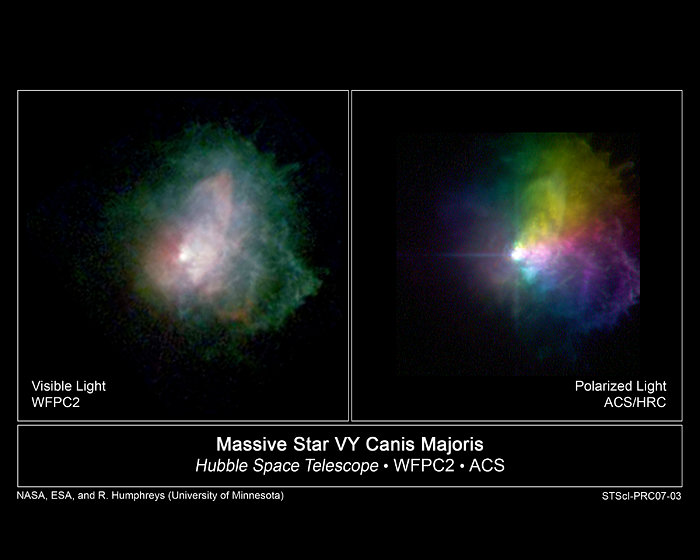Hubble Images Outbursts from Massive Star
These NASA/ESA Hubble Space Telescope images show the outflow from one of the brightest hypergiant stars in the sky, VY Canis Majoris.
The image on the left, taken with Hubble's Wide Field Planetary Camera 2, reveal its complex circumstellar ejecta, with arcs, filaments, and knots of material formed by the massive outflows. This image provided the first evidence that the brightest arcs and knots were created during several outbursts. The random orientations of the arcs also suggested they were produced by localized eruptions from active regions on the star's surface. This is composite picture from separate images taken in blue, green, red, and near-infrared light.
The image at right, taken with the Advanced Camera for Surveys, was made with polarizing filters to show how the dust ejected by the star is distributed in three-dimensional space. The light from the star becomes polarized when it is reflected off the dust. The dust formed around the star and was driven into space. To see the polarized light, astronomers used a polarizing filter, which lets through only light vibrating in one direction and blocks out light vibrating in other directions. Astronomers assembled this picture from separate images taken at three different polarization angles, colored red, green, and blue.
They measured the velocities of the ejecta from spectra obtained with the Keck 10-meter telescope. They also compared the ejecta's expansion taken with Hubble six years apart. These observations showed that the numerous arcs, loops, and knots were moving at different speeds and in various directions, confirming they were produced from separate events and from different locations on the star. The prominent arc to the northwest or upper right in the Hubble image is moving at 102,700 miles an hour (165,600 kilometers an hour), and was ejected about 500 years ago. The knots near the center of the image are traveling at 80,400 miles an hour (129,600 kilometers an hour).
The star, located 5,000 light-years away, is one of the largest and one of the most luminous evolved stars known. It is 500,000 times brighter and about 30 to 40 times more massive than the Sun.
The Wide Field and Planetary Camera 2 observations were taken March 22, 1999 and June 13, 2005. The Advanced Camera for Surveys images were taken Aug. 17, 2004.
Credit:About the Image
About the Object
| Name: | HD 58061, HIP 35793, VY Canis Majoris, VY Cma |
|---|---|
| Type: | Milky Way : Star : Type : Variable |
| Distance: | 3500 light years |
| Category: | Stars |
Colours & filters
| Band | Wavelength | Telescope |
|---|---|---|
| Optical B | 410 nm |
Hubble Space Telescope
WFPC2 |
| Optical POL0V | 550 nm |
Hubble Space Telescope
ACS |
| Optical V | 547 nm |
Hubble Space Telescope
WFPC2 |
| Optical POL60V | 550 nm |
Hubble Space Telescope
ACS |
| Optical (H-alpha+Near-IR) |
Hubble Space Telescope
WFPC2 | |
| Optical POL120V | 550 nm |
Hubble Space Telescope
ACS |
